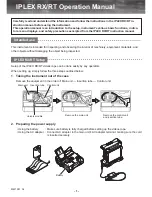
5
On installation
• The product should be installed by an expert who specializes in the installation
of the product. If you install the product yourself, wear appropriate work clothes.
Do not wear loose clothing that can become caught in moving parts. If you have
long hair, wear a hair net.
• Before installation, read the vehicle documentation to learn about the type of ve-
hicle and any special features that may be relevant.
• Look at blueprints to find out where the fuel lines, hydraulic lines, compressed
air and electrical lines are located. Make note of any modifications to the vehicle
that you might need to consider during installation.
• Ensure that the engine cannot accidentally start during installation.
• When removing or installing seats, covers, etc., make sure not to damage any
lines or disconnect any plugs.
• Make a note of all data stored in other installed devices with volatile electronic
memories.
Pay attention to the following during installation:
• During installation, ensure that the components of the product do not affect or
impair vehicle functions and do not become damaged themselves.
• Install only undamaged parts in a vehicle.
• During installation, ensure that the product does not impair visibility and is not
positioned in the head impact zone of the driver or passenger.
• When working on on-board electronics, do not wear metallic or conductive je-
welry such as necklaces, bracelets, rings, etc.
• If you have to work on a running engine, take special precautions. Always wear
appropriate work clothes due to risk of injury from crushing and burns.
• Before starting work, disconnect the negative terminal of the battery to avoid
short circuits. If the vehicle has additional batteries, the negative terminals of
these batteries may also need to be disconnected.
• Short circuits can cause cable fires, battery explosions and damage to other el-
ectronic systems. Remember that when you disconnect the battery, all volatile
electronic memories will lose their entries and must be reprogrammed.
• Before working on the engine compartment of a gas-powered ship engine, run
the engine compartment fan for at least five minutes.
• Note the paths of lines and wiring harnesses to avoid damaging them when dril-
ling or sawing.
• Do not install the product near the mechanical and electrical systems for the air-
bag.
• Do not drill holes or make openings in stabilizing struts or side bars.
• Before working under the vehicle, secure it in accordance with the manufactu-
rer's instructions.
• When choosing an installation location, make sure there is enough space be-
hind the holes or opening.






































